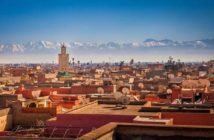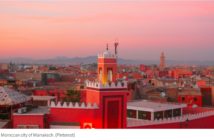MERZOUGA, Morocco – The muted cadence of the camels’ footsteps remains steady as the animals weave their way through the towering sand dunes of Erg Chebbi.
Only a few kilometers into the desert, human sense of direction seems lost, and the last signs of permanent habitation sink beyond the horizon.
When the sun sets here – in southern Morocco’s slice of the Sahara Desert –the dunes reflect a vibrant golden hue. The sky fades from a bright magenta to a deep indigo, and the only sounds are the low voices of the camel trek guides tending the animals and the whisper of the shifting sand swirling through the camp.
Of the countries that encompass the Sahara, Morocco’s general political stability and impressive tourism infrastructure make it one of the best locations to experience the mystery and thrill of the desert.
“To sleep under the stars in the Sahara is, I think, one of the experiences that everyone should have in his or her life,” said Omar Berhi, owner of Camel Trekking Morocco. The Merzouga-based travel company offers multi-day camel treks in Morocco’s Sahara Desert. “You’re very far from light, very far from the city noise. You sit over the dunes watching the sun set or the sun rise, and it’s very quiet, very calm.”
Several tour companies offer travelers the opportunity to visit Morocco’s desert, most centering around Erg Chebbi, the country’s largest erg – an area of shifting sand.
With an area of more than 42 square miles and dunes reaching as high as 525 feet, legend has it that the dunes were created when God buried a wealthy family in punishment for refusing to help a poor woman and her son.
Berhi’s Camel Trekking Moroccocompany offers several tour options, including a multi-day camel trek to Berber tent and cave communities – settlements of Morocco’s indigenous population – as well as sand boarding and dune riding. Think skiing, snowboarding and sledding minus the snow.
The most popular is the Authentic Morocco tour – a three-day, two-night trip from Marrakech, Morocco’s most popular tourist city, to Erg Chebbi, about an eight-hour drive away.
The Toyota Land Cruiser journey takes travelers across the rugged Atlas Mountains, through delicately balanced mountainside Berber villages and spends one night in a guesthouse near Dadas Gorge. Tourists follow the ancient path of caravans traveling from Timbuktu and pass by desert oases along the “Road of 1,000 Kasbahs,” ancient fortified strongholds.
The highlight of the tour begins on the town limits of Merzouga – the last outpost before the Sahara opens up into imposing dunes and the dark, flat, black desert beyond. As the Land Cruiser drives away in a cloud of dust, travelers meet their next mode of transport – Berhi’s relatively good-natured group of camels with names like Galileo and Brad Pitt.
The camels – more accurately called dromedaries with their single hump –kneel awkwardly for visitors to climb aboard, then pitch forward and back as they lumber to a standing position. With a little practice, travelers can easily acclimate to the bumpy ride, and are grateful when the camel’s wide feet act almost as snowshoes in the sinking sand.
Tethered to one another, the camels begin their journey into the dunes. “I felt like I was in another world,” said Jessica R. Appelson, a tourist from Madison, Wisc. She could imagine what it would have been like to travel in a caravan from Timbuktu.
Berhi is no stranger to tending camels. His father, an Army officer, owned several camels he used to patrol Morocco’s border with Algeria. As a child, Berhi, who began his business in 2000 when he was 25, recalls camel races in his village.
“We were lucky to have a white camel that always won the race,” he said. “It was very uncommon, most people respect more the white camels than the black camels; they are more unique.”
He left his village in the desert to study French at a university in the north, but he missed the way of life back home. “You just love your area,” he said.
He added that running the business was difficult at first because he had to take a bus to a neighboring town to access the internet so he could communicate with clients. When his town finally got an internet connection – and Camel Trekking Morocco developed a successful TripAdvisor presence – business picked up.
Now, one guide says they can barely keep up with demand. By the beginning of April this year, he hadn’t had a day off since January.
Part of the success could be that visitors feel like friends when traveling with Berhi or one of his two other guides. “We take guests as friends, not as tourists,” Berhi said. It’s not uncommon for a guide to invite guests to his family home for lunch along the way.
Back in the desert, travelers enter the dunes as sunset approaches – an ideal time to avoid the heat of the day. About halfway into the trek, a quick break allows visitors to climb the dunes and take in the scenery of the seemingly endless mountains of sand.
The journey continues for another hour or so to camp, where semi-permanent, and surprisingly comfortable tents are home for the night. A steep climb to the highest vantage point affords travelers the almost ethereal opportunity to watch the desert burst into color as the sun sets.
At camp, guides prepare tasty couscous for dinner, capped off with fireside drumming and joke-telling. Dawn comes much too early, and travelers climb back on the camels before daybreak, ascending the dunes one last time to watch the sun rise – a brighter, clearer light as the sun begins its day as well.
Reservations can me made online atcameltrekking.com, and Berhi offers a professional, quality and affordable operation. For just over $200 per person, the Authentic Morocco tour includes transport to and from Marrakech by SUV, two nights accommodation, two breakfasts and dinners, English-speaking guides and a memorable adventure in the desert on a camel.






